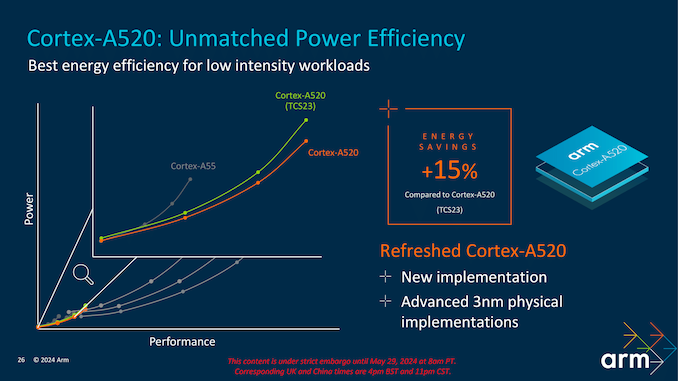Arm Unveils 2024 CPU Core Designs, Cortex X925, A725 and A520: Arm v9.2 Redefined For 3nm
by Gavin Bonshor on May 29, 2024 11:00 AM EST- Posted in
- CPUs
- Arm
- Smartphones
- Mobile
- SoCs
- Cortex
- 3nm
- Armv9.2
- Cortex-A520
- Cortex X925
- Cortex A725
Arm Cortex A520: Same 2023 Core Optimized For 3 nm
The Arm Cortex-A520 isn't architecturally different, nor has it been changed compared with last year's TCS2023 introduction. Instead, it has been optimized for the latest 3 nm process technology, enhancing its efficiency and performance. This core, part of the second-generation Armv9.2 architecture, delivers some additional compute power for everyday tasks in mobile and embedded devices while maintaining peak levels of energy efficiency and reducing power consumption expected from Arm's smallest core.
These architectural tweaks ensure that the Cortex-A520 can maximize the potential of the 3 nm process, achieving higher transistor density and better overall performance without any significant changes to its fundamental design.
The Cortex-A520 showcases a significant 15% energy saving compared to the Cortex-A520 (TCS23). This improvement is critical for devices with prolonged battery life, such as smartphones and Internet of Things (IoT) devices. By optimizing power consumption, the Cortex-A520 ensures efficient performance without compromising energy usage.
The graph on the above slide clearly illustrates the relationship between power and performance for the Cortex-A520 compared to its predecessor, the Cortex-A55, and the previous Cortex-A520 (TCS23). The latest Cortex-A520 explicitly designed for the 3 nm notably improves power efficiency across various performance levels. This means that the Cortex-A520 consumes significantly less power for a given performance point, demonstrating Arm's commitment to providing performance gains across 2024's Core Cluster and focusing on refining things from a power standpoint to the smallest of the three Cortex cores.











55 Comments
View All Comments
eastcoast_pete - Wednesday, May 29, 2024 - link
Speaking of SVE and SME: are there any applications (for Android, Windows-on-ARM or Apple devices) available to the general public that use either or both of them? SVE was originally co-developed by ARM and Fujitsu for the core that powers Fugaku, Riken's supercomputer. There are reports (rumors) that SVE is painful to implement, and someone wrote that Qualcomm elected to not enable SVE in their 8 Gen3 SoC, even though it's in their big cores. Anyone here knows, can comment? Right now, outside of 1-2 benchmarks, which applications actually use SVE, never mind SME? Replyname99 - Wednesday, May 29, 2024 - link
Presumably ARM’s Kleidi AI libraries (and various MS equivalents) use SVE and SME if present.And that’s really what matters. This functionality is envisaged (for now) as “built-in”.
Obviously they want developer buy-in over time, but that’s not what matters right now; what matters is what’s in the OS and API’s. Same as the fact that AMX was available to developers via Accelerate was great, but the primary user was Apple’s ML APIs. Reply
Marlin1975 - Thursday, May 30, 2024 - link
What do you mean, its all there. They went over the Optimized design that will take advantage of the synergies of the new NM tech from a leading edge lithography manufacture and lead them to greater performance. Its a win win for everyone, are you not onboard?:) Reply
syxbit - Wednesday, May 29, 2024 - link
I suspect this will still be worse than the A17 and the Nuvia chips. ReplyGC2:CS - Wednesday, May 29, 2024 - link
A17 and M3 and M4 did not show much benefit by going to the 3nm. If ARM can do better than only good for them. ReplyBGQ-qbf-tqf-n6n - Wednesday, May 29, 2024 - link
A17 was already 30% faster than S8G3 in single-core scores. In the same GB tests ARM is referring to, M4 is 27% faster still.Presuming the X925 is relative to the X4 with “36 percent faster”, they’ll still be behind M3, much less M4. Reply
OreoCookie - Saturday, June 1, 2024 - link
The speed ups in single and multi core were significant. To my knowledge the 10-core M4 is the fastest stock CPU in single core performance that was tested (about 13 % faster than Intel's Core i9 14900 KS, which clocks up to 6.2 GHz stock). The M3 is about 6 % behind the 14900 KS. (I am unaware of e. g. SPECmark results for the M4.) Replymode_13h - Saturday, June 1, 2024 - link
> I am unaware of e. g. SPECmark results for the M4.I'm pretty sure nobody is testing that, since Anandtech stopped doing it (i.e. after Andrei left). Reply
OreoCookie - Sunday, June 2, 2024 - link
Yeah, and it seems nobody is doing it consistently across several generations. The best dissection of the M3 architecture I remember was by a Chinese Youtube channel, but nobody is carrying the baton. Maybe Ian and Andrei are doing this as part of their work for clients. (Andrei, I think, is working for Qualcomm now, isn't he?) Replymode_13h - Monday, June 3, 2024 - link
name99 would know what M3 analysis is out there. He wrote/compiled the Apple M1 explainer, which is a 300-page PDF you can find with all the details about it.https://github.com/name99-org/AArch64-Explore/ Reply